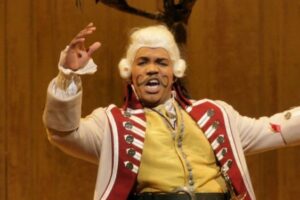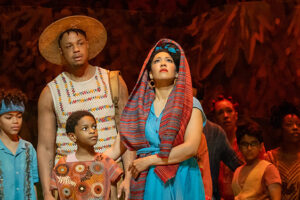

We’ve had some great productions but there’s always been something wanting. For the first decade the orchestra was pretty awful and no one in the audience knew where to applaud. They still don’t know how to dress. When the company would attempt something musically major like Wagner or Berg they’d actually hire the Philharmonic for the pit. Then there’s the advertising that’s strictly bush league. It’s hard to take a company seriously that mounts a major production of Berlioz’s epic, hires Charles Dutoit to conduct, and calls it The Trojans. We don’t even get the ‘und’ in Wagner’s opera, it’s Tristan AND Isolde. The cultural equivalent of a buzz kill as far as I’m concerned.
We’ve gotten a lot of package deals with directors or tenors foisting their wives on us in roles, both in front of and behind the curtain, that they weren’t suited for. My first Fidelio was with Karan Armstrong as Leonore who was married to the director of the production, Götz Friedrich. She couldn’t even make it through to the end of ” Aubscheulicher!”. Don’t get me started on Petra-Maria Schnitzer’s Ariadne just so we could have Peter Seiffert as Bacchus in the Strauss. Mrs. Domingo directs. Not sure anyone else noticed. We had an unknown Isolde making a role debut who hasn’t been heard from since.
So, no surprise that Uncle Placido should decide to include Los Angeles on his Simon Boccanegra World Tour. Since he started singing the baritone lead in this opus in 2009 this may well be the most well documented portrayal of any singer in an operatic role since Maria Callas in Traviata, including commercial DVD’s from The Met, Covent Garden, and La Scala. The only reason I went was because I was gifted with a ticket.
Which brings me to the topic of coin. At the LA Opera it’s all about the money and I’d like to know where it goes exactly ? The walls of the Music Center and the Dorothy Chandler are like a mausoleum of long dead contributors. The program for Boccanegra literally lists hundreds of donors. When you sit down at your seat there’s a credit roll on the super-title screen that mentions all the biggest benefactors for the evening, Rolex, Eli & Edith Broad, the Annenberg’s, the Getty’s. Now, I did see a great performance of Puccini’s La Fanciulla del West that was sponsored by Wells Fargo Bank but that was the only time it was actually appropriate. Frankly, it’s just vulgar and it diminishes whatever artistic attempts are made. We had a 25th Anniversary Gala with tables on the stage. No audience in the theatre. Very cliquey. It’s also the kind of place where you discover that people like Chevy Chase and Jo Anne Worley are big opera fans.
For this we get Elijah Moshinsky’s borrowed Covent Garden production from 1991 with a serviceable semi-unit set cleverly designed by Micheal Yeargan and sumptuous, for us, costumes by Peter J. Hall. It’s a big step up from our average production values which are just a tad above School Holiday Pageant. You can see our company’s Traviata on DVD: it’s sad.
Thank goodness for those supertitles too because in this opera you need them. I’m pretty sure there are members of the cast who wonder what’s going on halfway through this epic. Plausibility runs pretty low but it is a beautiful score even if you can see the seams where Piave and Boito meet.
First, we had the luxury of Paolo Gavanelli as the villainous Paolo. He made a magnificent impression from his first hushed utterance in the prologue to his last march to the gallows in the final act. The prosciutto is sliced pretty thick in this role and he took advantage of every moment. His curse in the council chamber scene was just what you’d want.
Then, our Fiesco is Vitalij Kowaljow who was the Wotan in the Ring Cycle here last year. He’s got a really beautiful rolling bass and he poured forth in “Il lacerto spirito” all the way down to Verdi’s low G-flat. He easily commanded the Italian style and the stage, worked his cape like a pro, and did some of his best singing in the religious duet in Act I with the Gabrielle Adorno, Stefano Secco who was making his LA Opera debut. Secco has a bright, bantam-weight sound that was very even top to bottom. Although he may be lacking a little bloom in the high part of his voice he negotiated his fairly thankless aria well and did some extraordinary piano singing above the staff in the final act.
When I saw Domingo as Siegmund in the Ring here I left the theater thinking to myself that it was most certainly the last time I would see him live. His performance in the Walkure was nothing short of astonishing for a man of 69 but you could tell it was hard work. Unburdened as Boccanegra with the tenorial tessitura he exhibits a freedom and grace onstage that continues to amaze. In the prologue I almost didn’t believe it was he at first. He bounded about the stage in a dark wig like a man half his years.
As the evening continued you could see why he wanted to play this part and what a perfect fit it makes for him. He still sings honestly with his own, now very burnished, burgundy tenor voice but his musicianship and breath make you aware of how spoiled we’ve been and perhaps have taken this very great artist a little bit for granted in his normal repertoire. I was sorry they chose to costume him in a tea cozy once his character took the throne and but then was grateful for the padding when he threw himself to the stage, on his back no less, at the finale of his death scene. I think he slid two feet. I figured he’d just slump over on the nearby bench but he wanted to make certain we all got our money’s worth.
In 2005 I enjoyed a raucous performance of Il Barbiere di Siviglia in Santa Fe with a good cast. I remember being off put by the fact that that I was seeing a soprano Rosina, which I thought was old school and although she sang well, it wasn’t memorable enough for it to register. Only later did I realize that this was the same artist I saw as Amelia Grimaldi on Thursday night. Ana Maria Martinez is unrecognizable as the chirping colouratura I encountered seven years ago in New Mexico.
She has matured into a baby Verdi soprano of magnificent facility and a dead center accuracy of pitch. Listening to her makes you aware of how many singers attack every note from below as a matter of technique and style. She made short work of her opening aria with its ungainly note spans and in the penultimate phrase unleashed the first of many of the evening’s stunning pianissimi. She moved beautifully and her singing displayed a rare poise and delicious sense of strength held in reserve. In short, I have a new diva to worship. I cannot wait to hear her again.
James Conlon led the orchestra well in a spacious and autumnal reading that didn’t lack fire when needed. He’s most definitely a singer’s conductor and his support was apparent throughout in little ways that encouraged the cast to do their best. The chorus seemed a tad underpowered but that’s nothing new, I assure you. Very evocative lighting by Duane Schuler including a nifty effect on the drop curtain during the prelude.
Lot’s of torches and gloom. I’ll have to seek out the Covent Garden DVD now.
Photo by Robert Millard.























Comments